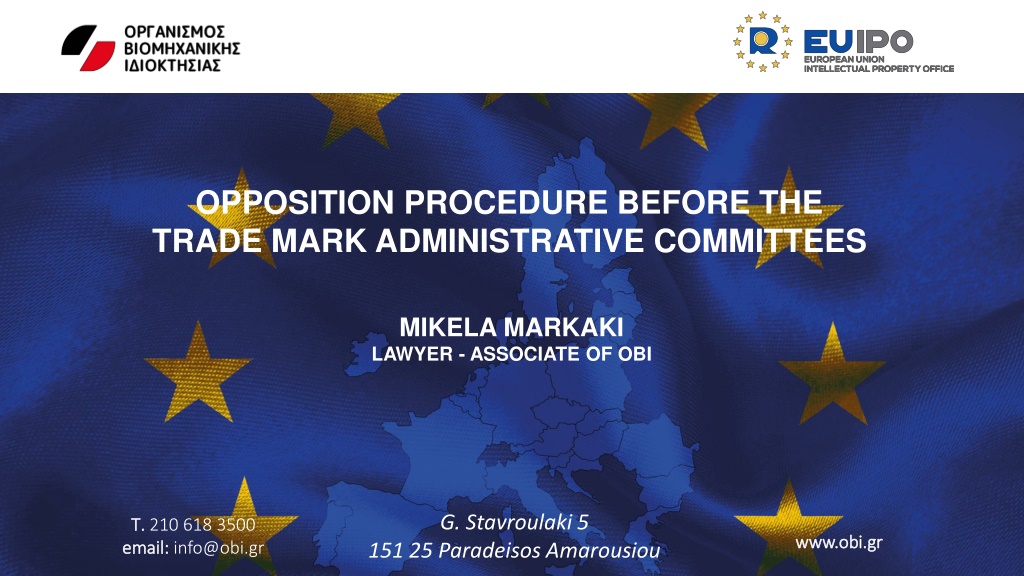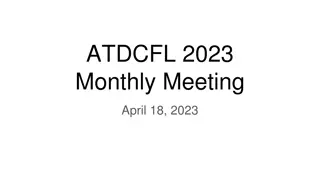
Opposition Procedure in Trade Mark Law
Explore the opposition procedure before the Trade Mark Administrative Committees as a remedy to challenge decisions related to trade mark registration. Learn about the main grounds for filing opposition and the significance of protecting earlier rights under the relevant laws.
Download Presentation

Please find below an Image/Link to download the presentation.
The content on the website is provided AS IS for your information and personal use only. It may not be sold, licensed, or shared on other websites without obtaining consent from the author. If you encounter any issues during the download, it is possible that the publisher has removed the file from their server.
You are allowed to download the files provided on this website for personal or commercial use, subject to the condition that they are used lawfully. All files are the property of their respective owners.
The content on the website is provided AS IS for your information and personal use only. It may not be sold, licensed, or shared on other websites without obtaining consent from the author.
E N D
Presentation Transcript
OPPOSITION PROCEDURE BEFORE THE TRADE MARK ADMINISTRATIVE COMMITTEES MIKELA MARKAKI LAWYER - ASSOCIATE OF OBI G. Stavroulaki 5 151 25 Paradeisos Amarousiou . . 210 618 3500 email: email: info@obi.gr www.obi.gr www.obi.gr
INTRODUCTION INTRODUCTION Opposition for the purpose of article 25 of L. 4679/2020 is the remedy, which challenges the decision of the Examiner of the Trade Mark Service or the Trade Mark Administrative Committee or the final decision of the Administrative Courts, which may, as the case may be, have accepted the Trade mark Application, on the grounds that its registration is precluded by one or more absolute grounds of refusal set forth in article 4 or relative grounds of article 5 of the above Law. Opposition in essence constitutes a formal objection against the registration of a trade mark. The Opposition is lodged by means of a document which is filed at the Trade Mark Service of the Hellenic Industrial Property Organisation and is forwarded for examination of the Trade mark Administrative Committee, even if the Trade mark Application was accepted by final decision of the Administrative Courts. The purpose of exercising such remedy is the fullest protection of the proprietor of the earlier right, with respect to the relative grounds of refusal that is set forth in article 5 of Law 4679/2020, as well as the protection of any natural or legal person with respect to the absolute grounds of refusal set forth in article 4 of the same law. In this sense, the relative grounds for refusal aim to protect earlier rights, while absolute grounds of refusal aim, first and foremost, to ensure free competition and to avert the possibility of registering the trade mark and therefore to monopolise an indication that all the competitors need to use.
MAIN GROUNDS FOR FILING FOR OPPOSITION The main grounds for filing an Opposition relate to the likelihood of confusion between the two trade marks (relative grounds for refusal), as well as the existence of bad faith (absolute grounds of refusal) on behalf of an applicant of a later trade mark. Therefore, the proprietor of an earlier right, lodging the Opposition, may hinder the registration of the sign: o if it is identical with the earlier trade mark or earlier right and the goods or services for which registration is applied for or registration effected are identical with the goods or services for which the earlier trade mark is protected; o o if, because of its identity with, or similarity to, the earlier trade mark and the identity or similarity of the goods or services covered by the trade marks there exists a likelihood of confusion on the part of the public and/or the likelihood of association of the businesses involved. o If the sign is identical with, or similar to, an earlier trade mark, which has a reputation, irrespective of whether the goods or services for which it is applied are identical with, similar to or not similar to those for which the earlier trade mark is registered, and where the use without due cause of the trade mark applied for would take unfair advantage of, or be detrimental to, the distinctive character or the repute of the earlier trade mark. o The existence of bad faith on behalf of an applicant of a later trade mark, relates to the motive of the applicant and therefore contains a dose of subjectivity. This concept implies a general knowledge, actual or substantiated, that the act harms the interests of a third party, in other words the applicant of a later trade mark should know that the sign being registered, is widely used by a third party, a fact which is difficult to prove.
EXAMINATION OF THE RELATIVE GROUNDS OF REFUSAL SPECIFICALLY Specifically, In the examination of the relative grounds for refusal, the sign is not accepted as a trade mark if it is proven that this comprises an infringement of an earlier right, which is used to distinguish it from the same or a similar product, in order to avert the likelihood of confusion. In order to assess the risk of confusion, three parameters are assessed: o The similarity of the signs: Such similarity can be visual, phonetic and conceptual and accepting that one of the three exists suffices in the examination of the risk of confusion, pursuant , however, to the global appreciation of all the relevant factors of the case, with the global impression created to the recipient of the services being a decisive factor. o The similarity of the products, which determines the regulatory scope of the trade mark in transactions. relevant appreciation are the nature and the destination of the products, characteristics to which consumers attach great importance. In that light, products are similar, when destined for similar purposes or uses, address the same circle of consumers and are distributed through the same distribution channels. o The distinctive force of the trade mark which is being contested, is assessed through a global approach both with respect to the products, for which registration is sought and with respect to the perception of the consumers for the specific products/services. Thus, the more distinctive the contested trade mark, the greater the risk of confusion from the use of a counterfeit sign in transactions. Decisive factors in the
EXAMINATION OF SPECIFICALLY THE RELATIVE GROUNDS OF REFUSAL The risk of confusion, includes the risk of association between two signs, which pertains to the possibility that two signs, which may not carry the risk of confusion when compared to each other independently, create however the impression that the products under the trade mark originate from the same undertaking, or perhaps from different undertakings, which however collaborate with each other. It should be noted, that, according to established case-law of Union courts, the concept of the average consumer of the corresponding category of products, whose perception has become a key parameter in weighing the likelihood of confusion from counterfeiting or imitation products, is specified to mean the consumer , who is deemed to be reasonably well-informed and reasonably observant and circumspect. Finally, beyond the assessment of the risk of confusion and/or association, which were mentioned above, a decisive factor in trade mark law is the protection of reputation, which pertains to the high recognisability of the trade mark from its consumer public, irrespective of whether the products or services for which it was registered are identical or similar with those for which the earlier mark was registered. It is sufficient to prove that the use of the later mark without due cause would take unfair advantage of the distinctive character or repute of the earlier mark or be detrimental to the said distinctive character or reputation of the earlier mark .
HOW IS AN OPPOSITION LODGED The Opposition is filed within a deadline of three (3) months, which commences the day after the publication of the decision of the Examiner of the Trade Mark Service or the Trade Mark Administrative Committee or the final decision of the Administrative Courts, which, as the case may be, accepted the Trade mark Application. The Opposition document should contain substantiated and fully documented legal grounds, the facts as well as the relevant reference to theory, as well as Jurisprudence. The Opposition is lodged by the proprietor of the earlier right or even the licensees authorised by the proprietors of the earlier mark, through their attorneys. The Opposition is lodged with the Organisation s Trade Mark Service. There is a seventy euro fee (70 ) for lodging the opposition and a forty euro ( 40) fee for it to be discussed before the Trade mark Administrative Committee, as well as the requisite Advance Payment Notes for of the Bar Association to be paid.
Immediately upon filing the opposition, the Trade Mark Service assigns a protocol number to the opponent with the date of submission and the date of the hearing before the Trade mark Administrative Committee. It should be noted here that the opponent shall procure that a certified copy of the Opposition, with the act designating the hearing date and the related summons, shall be notified to the applicant or their agent, by bailiff, at least thirty (30) full days prior to the meeting of the Trade mark Administrative Committee. If the deadline lapses, the Opposition shall be inadmissible and dismissed. The Trade Mark Administrative Committee shall convene on the hearing date set, in accordance with the procedure set forth in article 30 of Law 4679/2020. The Trade Mark Administrative Committee rules on the Opposition, pursuant to the adversarial system, on the basis of the whole body of evidence that has been placed at its disposal by the parties and reaches a decision accordingly.
WHICH ARE THE POSSIBLE OUTCOMES After an exhaustive examination of the Opposition grounds put forth, as well as all the relevant documents submitted, the Trade Mark Administrative Committee shall issue its decision. This decision may: uphold the Opposition and therefore be subject to Appeal by the applicant before the Administrative Courts; partially uphold the Opposition and therefore to be subject to Appeal by both Parties before the Administrative Courts, whereby each party contests that part that was not upheld and which is detrimental to it, and Dismiss the Opposition and therefore be subject to Appeal by the opponent before the Administrative Courts; o o o However, the involved parties are free to reach a settlement and agreement of their own accord. Finally, it should be noted that the involved parties can submit a joint application for mediation at any point in time after lodging an opposition with the Trade Mark Service of the Hellenic Industrial Property Organisation, which results in the suspension of the proceedings before the Trade mark Administrative Committee.
TAKE HOME POINTS Opposition is a valuable remedy for every natural or legal person that wants to protect its trade mark and therefore its business, from a competitor. Lodging an Opposition requires adhering to the correct filing procedure and deadlines, as well as submitting a fully substantiated and reasoned case file. The outcome of the Opposition is based on all of the above prerequisites in order to protect the rights of applicants. In order to better understand the above, it would be useful to watch seminars with real examples, which can be found on the European Union Intellectual Property Office s Academy learning portal (EUIPO ECP3 ALP project).
THANK YOU G. Stavroulaki 5 151 25 Paradeisos Amarousiou . . 210 618 3500 email: email:info@obi.gr www.obi.gr www.obi.gr








